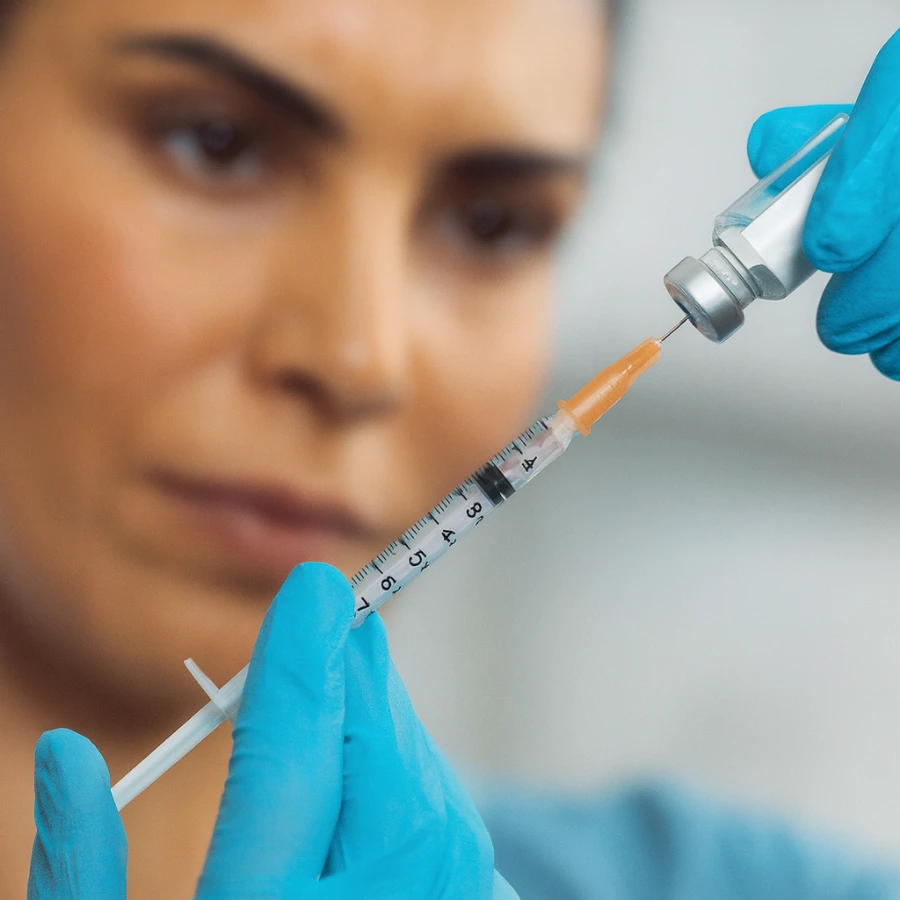Key Takeaways
- Always convert patient weight to kilograms and use dimensional analysis to calculate safe, accurate dosages under pressure.
- Use validated tools like dose cards and pediatric length-based tapes to reduce cognitive load and prevent errors.
- Drip rates, mg-to-mL conversions, and pediatric dosages follow reliable formulas that can be applied quickly with practice.
Safety Starts Before the Math
The Six Rights of Medication
Every successful medication administration begins with confirming the six rights: patient, drug, dose, route, time, and documentation. This simple framework reduces the chances of preventable errors under pressure. EMTs and paramedics should use these checks out loud, even during fast-paced emergencies. Repetition reinforces safety and helps team members spot potential oversights. Involving a partner in verbal confirmation can also build a stronger safety culture in the rig. A study published by BMC Nursing emphasizes that consistent adherence to the six rights significantly lowers error rates in medication administration.
Why Kilograms Matter More Than You Think
Weight-based dosing is standard for many drugs, especially in pediatrics, and kilograms—not pounds—are the universal metric. Converting pounds to kilograms before dosing is not optional; it is essential. Always divide the patient’s weight in pounds by 2.2 to convert to kilograms. Document the result clearly in your ePCR or worksheet before beginning drug calculations. Maintaining consistency with metric units avoids downstream errors, especially when handing off care.
Stop Relying on Memory—Use Validated Tools
Even experienced medics make fewer mistakes when using standardized aids. Length-based tapes like Broselow provide pre-calculated doses, equipment sizes, and color-coded references. Agency-issued dose cards or mobile protocol apps should be consulted before drawing medication. These tools eliminate the need for mental math under stress. The most accurate EMS teams consistently combine tools, verbal double checks, and real-time documentation. A 2022 controlled study confirmed that using precalculated pediatric mL dosing systems dramatically improved dosage accuracy in emergency settings.
From Ordered Dose to Administered Volume
Dimensional Analysis: The Cleanest Method
Dimensional analysis is the most reliable method to calculate medication volume. Start with the ordered dose in mg, and divide by the concentration (mg per mL). This ensures units cancel properly and highlights conversion mistakes instantly. For example, an order for 0.3 mg of epinephrine IM from a 1 mg/mL vial results in 0.3 mL. This single-line calculation works for nearly any medication in the field.
Ratio Labels Are Dead—Here’s the Modern Format
Old ratio-based labels like 1:1,000 or 1:10,000 have been phased out for safety reasons. The current FDA standard expresses concentration in mg/mL to avoid ambiguity. For example, a 1:10,000 epinephrine syringe now reads 0.1 mg/mL, and a 1:1,000 vial reads 1 mg/mL. Always verify the concentration visually before drawing any dose. This shift eliminates confusion and aligns with national safety protocols.
A Quick Guide to IV Drip Rate Calculations
Setting up a manual drip requires a simple formula: (volume in mL × drop factor) ÷ time in minutes. Use this to determine gtt/min, or drops per minute. Drop factors vary by tubing: 10, 15, or 20 gtt/mL for macrodrips, and 60 gtt/mL for microdrips. For instance, delivering 100 mL over 30 minutes with a 10 gtt/mL set results in 33 gtt/min. This formula is standard in nursing and EMS training programs for accurate IV administration.
Use this chart as a quick-reference guide for common IV drip sets encountered in prehospital care. It outlines standard drop factors and typical clinical scenarios for each tubing type.
| Tubing Type | Drop Factor (gtt/mL) | Common Use Cases |
|---|---|---|
| Microdrip Set | 60 gtt/mL | Pediatric patients, medications requiring precise volume control |
| Macrodrip Set | 10 gtt/mL | Rapid fluid replacement (e.g., trauma, shock) |
| Standard Macrodrip | 15 gtt/mL | General-purpose infusions in adults |
| Blood Set Tubing | 10 gtt/mL | Blood product administration requiring wide-bore sets |
Reliable Shortcuts You Can Actually Use
Estimating Kilograms from Pounds in Your Head
When calculators aren’t accessible, use mental math for fast conversions. Halve the patient’s weight in pounds, then subtract 10 percent of that half. This shortcut closely estimates kilograms. For example, 150 lb × 0.5 = 75, then subtract 7.5 = 67.5 kg. While not perfect, this method offers a reliable backup when time is tight. Always confirm with exact calculations when possible.
mL/Hour and gtt/min Made Easy
Microdrip tubing simplifies drip rate math because 60 gtt/mL aligns with mL/hr. This means that 120 mL/hr roughly equals 120 gtt/min on a microdrip set. Use this one-to-one rule when quick adjustments are needed during fluid administration. For macrodrip tubing, revert to the full drip-rate formula. Having both methods available improves adaptability across different scenarios.
Cross-Checking with Partner Echo-Backs
Verbal cross-checks with a partner add an extra layer of error prevention. Say the drug name, dose, route, and volume aloud before drawing or injecting. Have your partner repeat it back and verify the label. This process takes seconds but prevents tragic mix-ups. It is especially critical with pediatric doses, sedatives, or vasoactive agents. Always include this step in your pre-injection routine.
Examples That Match Real EMS Calls
Cardiac Arrest Dosing in Pediatrics
During pediatric resuscitation, epinephrine dosing follows the rule: 0.01 mg/kg of a 0.1 mg/mL solution. For a 20 kg child, the dose equals 0.2 mg. Divide by the concentration (0.2 mg ÷ 0.1 mg/mL) to get 2 mL. This volume is drawn from a prefilled 10 mL syringe. Timely and correct dosing can improve outcomes, especially when coordinated with effective compressions.
Intramuscular Epinephrine for Anaphylaxis
Adults experiencing anaphylaxis typically receive 0.3–0.5 mg of epinephrine IM. The concentration used is 1 mg/mL. To calculate volume: 0.3 mg ÷ 1 mg/mL = 0.3 mL. Administer in the mid-thigh using a high-flow needle. Monitor the patient for improvement and reassess frequently. Repeat doses may be required depending on the severity and protocol.
Setting Up a Gravity Drip Under Pressure
Suppose your patient needs 250 mL of fluid over 60 minutes using a 15 gtt/mL set. Multiply volume by drop factor (250×15 = 3750) and divide by time (3750 ÷ 60 = 62.5). Round to 63 gtt/min for drip rate. Use a watch or timer to confirm consistency. Recheck after patient movement or elevation changes.
Use this quick-reference dosage table for common epinephrine scenarios in the field. It reinforces accuracy and complements the step-by-step examples previously shown.
| Scenario | Weight / Age | Dose (mg) | Volume (mL) |
|---|---|---|---|
| Pediatric Cardiac Arrest (IM) | 20 kg child | 0.2 mg | 2 mL (0.1 mg/mL) |
| Adult Anaphylaxis (IM) | Adult | 0.3 mg | 0.3 mL (1 mg/mL) |
| Cardiac Arrest Push-Dose (IV) | All ages | 0.01 mg (10 mcg) | 1 mL (0.01 mg/mL) |
| Neonate (IM, if weight unknown) | Assume < 5 kg | 0.1 mg | 0.1 mL (1 mg/mL) |
Common Pitfalls—and How to Avoid Them
Never Trust Just the Label Without Math
Drug labels can look similar even when concentrations differ. Always read the concentration in mg/mL and do the math. Avoid assuming volume from color or packaging. Double-check against your dose card or protocol app. Dosing based on assumption leads to potentially fatal mistakes. Stay alert and deliberate with each calculation.
Don’t Mix Up mg, mL, or mcg
A frequent source of error is misreading or miscalculating between mg, mL, and mcg. Know that 1,000 mcg equals 1 mg. Always match the unit on the order with the unit on the vial. Convert if necessary before performing calculations. Review units aloud during your echo-check process. Consistency and clarity prevent overdoses and underdoses.
When to Use a Reference Instead of Calculating
Not all scenarios call for on-the-spot math. Use protocol apps, length-based tapes, or agency-approved charts for pediatric patients, rare drugs, or infusions. These references are designed to eliminate mental fatigue and reduce variability. Leaning on approved tools is not weakness—it is good medicine. Check for updates periodically to stay aligned with current standards.
FAQs on Field Drug Calculations
What is the most reliable way to calculate drug doses?
Dimensional analysis ensures units cancel properly and prevents common math mistakes. It is widely recommended.
How do I convert pounds to kilograms quickly?
Divide the weight in pounds by 2.2. A quick mental estimate halves the pounds and subtracts 10%.
What does 1 mg/mL mean on a vial?
It means one milligram of medication is present in every one milliliter of fluid in the vial.
Are prefilled syringes always ready to use?
Check the label carefully—verify the concentration and expiration before administration.
When should I skip manual math?
Use validated tools like length-based tapes or dosing cards for pediatrics or high-risk meds.

Jeromy VanderMeulen is a seasoned fire service leader with over two decades of experience in emergency response, training, and public safety management. He currently serves as Battalion Chief at the Lehigh Acres Fire Control & Rescue District and is CEO of the Ricky Rescue Training Academy, a premier provider of online and blended EMT and firefighter certification programs in Florida.
Jeromy holds multiple degrees from Edison State College and the Community College of the Air Force, and is pursuing his MBA at Barry University. He maintains top-tier certifications, including Fire Officer IV, Fire Instructor III, and Fire Inspector II, and has served as a subject matter expert for a court case. He is a member or the Florida Fire Chiefs Association.
Jeromy also contributes to state-level fire safety regulation and serves on several hiring and promotional boards.

